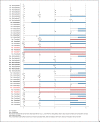Validation of the Apraxia Screen TULIA (AST) in Schizophrenia
- PMID: 35367989
- PMCID: PMC9533426
- DOI: 10.1159/000523778
Validation of the Apraxia Screen TULIA (AST) in Schizophrenia
Abstract
Introduction: Deficits in social interaction and community functioning, including impaired use, performance, and perception of hand gestures, are key features in schizophrenia. A well-established tool to assess gesture deficits is the test of upper limb apraxia (TULIA). However, given its time-consuming application based on video analyses, research has proposed the bedside apraxia screen of TULIA (AST). This study aims to test the validity and reliability of the AST to detect gesture abnormalities at bedside in a sample of 27 patients diagnosed with schizophrenia, schizotypal disorder, acute and transient psychotic disorders, or schizoaffective disorder.
Methods: Patients completed the 48-item TULIA and the 12-item AST. Two different raters assessed the AST: one at bedside (online) and the other based on the video recordings.
Results: The total AST scores demonstrated a high parallel reliability, moderate inter-rater reliability on a single-item level, and good construct validities.
Conclusions: The psychometric properties of the AST suggest it can well be used for the clinical assessment of gesture deficits in schizophrenia. However, when detailed information is required, the AST rated from video or conducting the full TULIA is recommended. The findings call for refining the selection of the TULIA items for a psychosis-AST bedside test to increase specificity.
Keywords: AST; Hand gestures; Nonverbal communication; Schizophrenia spectrum disorders; TULIA.
© 2022 The Author(s). Published by S. Karger AG, Basel.
Conflict of interest statement
The authors have no conflicts of interest to declare.
Figures




Similar articles
-
A new bedside test of gestures in stroke: the apraxia screen of TULIA (AST).J Neurol Neurosurg Psychiatry. 2011 Apr;82(4):389-92. doi: 10.1136/jnnp.2010.213371. Epub 2010 Oct 9. J Neurol Neurosurg Psychiatry. 2011. PMID: 20935324
-
The reliability and validity of the Turkish version of the apraxia screen of TULIA in multiple sclerosis patients.Disabil Rehabil. 2022 Dec;44(25):8042-8047. doi: 10.1080/09638288.2021.2003447. Epub 2021 Dec 13. Disabil Rehabil. 2022. PMID: 34898347
-
Comprehensive assessment of gesture production: a new test of upper limb apraxia (TULIA).Eur J Neurol. 2010 Jan;17(1):59-66. doi: 10.1111/j.1468-1331.2009.02741.x. Epub 2009 Jul 9. Eur J Neurol. 2010. PMID: 19614961
-
Gesture deficits and apraxia in schizophrenia.Cortex. 2020 Dec;133:65-75. doi: 10.1016/j.cortex.2020.09.017. Epub 2020 Oct 3. Cortex. 2020. PMID: 33099076 Free PMC article. Review.
-
[How to diagnose and treat limb apraxia].Fortschr Neurol Psychiatr. 2011 Jun;79(6):345-57. doi: 10.1055/s-0029-1246097. Epub 2011 Apr 8. Fortschr Neurol Psychiatr. 2011. PMID: 21480158 Review. German.
Cited by
-
Using virtual reality to assess gesture performance deficits in schizophrenia patients.Front Psychiatry. 2023 Jun 9;14:1191601. doi: 10.3389/fpsyt.2023.1191601. eCollection 2023. Front Psychiatry. 2023. PMID: 37363173 Free PMC article.

